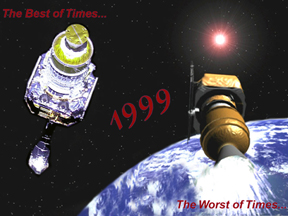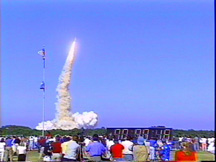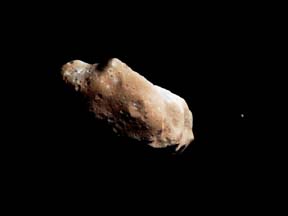This map shows which areas of the Greenland glacier are shrinking and
which are growing.
Click on image for full size
Image courtesy of NASA
Scientists Find Greenland Glacier Shrinking
News story originally written on March 13, 1999
Using an airborne laser altimeter, scientists have measured changes in the
thickness of the Greenland glacier over the past five years. While some
parts of it have grown, overall the glacier has been shrinking. In some
places, such as near the southeast coast, it has shrunk up to 30 feet over
five years.
"Why they are behaving like this is a mystery," said Bill Krabill,
Principal Investigator at the Goddard Space Flight Center's Wallops Flight
Facility, "but it might indicate that the coastal margins of ice sheets
are capable of responding quite rapidly to external changes, such as a
potential warming of the climate."
Scientists originally flew across the southern part of the Greenland
glacier in 1993 and then reflew the same routes in 1998 with the help of
the Global Positioning System. These measurements will be augmented by
NASA's ICESAT spacecraft, which is scheduled to launch in 2001.
You might also be interested in:

It was another exciting and frustrating year for the space science program. It seemed that every step forward led to one backwards. Either way, NASA led the way to a great century of discovery. Unfortunately,
...more
The Space Shuttle Discovery lifted off from Kennedy Space Center at 2:19 p.m. EST, October 29th. The sky was clear and the weather was great as Discovery took 8 1/2 minutes to reach orbit for the Unitied
...more
A moon was discovered orbiting the asteroid, Eugenia. This is only the second time in history that a satellite has been seen circling an asteroid. A special mirror allowed scientists to find the moon
...more
Will Russia ever put the service module for the International Space Station in space? NASA officials are demanding an answer from the Russian government. The necessary service module is currently waiting
...more
During a period of about two days in early May, 1998, the ACE spacecraft was immersed in plasma associated with a coronal mass ejection (CME). The SWICS instrument on ACE, which determines unambiguously
...more
J.S. Maini of the Canadian Forest Service has referred to forests as the "heart and lungs of the world." Forests reduce soil erosion, maintain water quality, contribute to atmospheric humidity and cloud
...more
In late April through mid-May 2002, all five naked-eye planets are visible simultaneously in the night sky! This is includes Mercury which is generally very hard to see because of its proximity to the
...more









